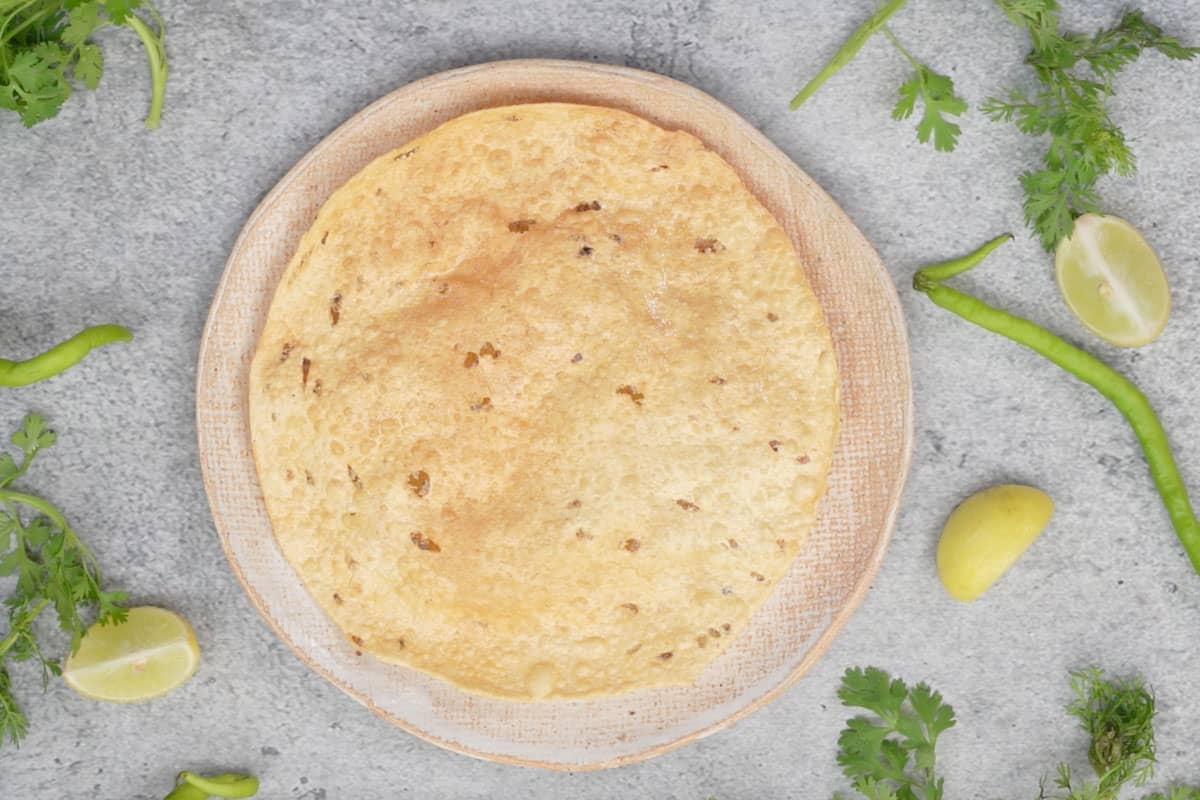Papad: Nutritional Profile
Before talking about papad’s effects on your health, let us find out what it exactly is. Knowing the basics of its preparation will help us know its nutritional details better. Papad is a thin, crispy, and disc-like snack or appetiser.
It is also called papadum in many parts of India. When you think of papadum, calories swim before your eyes, don’t they? It doesn’t necessarily have to be so.
Papad or papadum is made out of lentils and Indian spices. Lentils such as urad dal, moong dal, chickpea, etc., are used to make the dough. Along with the ground lentil flours, many other flours, including rice, soy, and cereal flours, can also be mixed together to make papad.Read on to understand the nutritional facts of papad.
Here is the nutritional information for 100 grams of papad:
| Nutrient | Amount |
| Total Fat | 3.25 g |
| Cholesterol | 4 mg |
| Sodium | 1740 mg |
| Potassium | 1000 mg |
| Carbohydrates | 59.9 g |
| Dietary Fibre | 18.6 g |
| Protein | 25.6 g |
Papad and Diabetes: The Glycemic Impact
Glycemic Index (GI):
- Range: 45-85
- Lentil-based (roasted): ~45-55 (low to medium)
- Rice-based (fried): ~80-85 (high)
- Average: ~60 (medium)
Glycemic Load (GL):
- Per 15g serving (1-2 small papads, ~9g carbs):
- Lentil (GI 45): ~4 (low)
- Average (GI 60): ~5-6 (low)
- Rice (GI 85): ~7-8 (low to medium)
Vary by Papad Types:
- Lentil (urad/moong): Lower GI (45-55) due to fiber/protein.
- Rice/sabudana: Higher GI (70-85), less fiber, faster digestion.
- Prep: Roasted keeps GI lower; frying raises it slightly.
Is Roasted Papad Healthier?
Papads can be made at home in any way you prefer. They are available in many flavours, sizes, shapes, etc. Papads are either roasted or fried.
Roasted papad is a better option when compared to fried papad as it contains less or no oil and is therefore much healthier and lower in calories.
Can Diabetics Consume Papad?
The answer would be Yes and No! The key is to know the right way of including it in your diet. The fibre and protein content in papad is beneficial for diabetics. It also has a low glycemic index of 46 and thus does not cause sudden spikes in your blood sugar levels.
However, papads are carbohydrate-rich, with 100 g papad containing about 60.0 g carbohydrates. Thus, it is best to consume papad in moderation. You can have 2 to 3 papads in a week. Also, while choosing papad, opt for roasted papad over fried ones. Adding chopped vegetables such as cucumbers, tomatoes, onions and spices such as cumin powder and pepper powder to your papad can improve its nutritional value.
Wondering if your favorite foods are diabetes-friendly? Get the facts on what’s safe and what’s best to avoid.
Ways to Consume Papad for Diabetes

There are several ways of including papad in your daily diet. Here are a few ideas:
- Make masala papad by adding spices such as cumin powder and pepper powder and a variety of ingredients such as tomatoes, chillies, and coriander leaves over roasted papad.
- You can also load up your papad with roasted chicken, spiced pepperoni or spiced keema.
- The papad can be cut into pieces to make nachos at home, that can be loaded with chopped vegetables and enjoyed with ketchup or your favourite dips.
- Papads can also be folded into any desired shape while roasting to make tacos out of them and can be filled with vegetables, meat, nuts, and cheese.
- You can even use crushed roasted papads in your rolls and chaats.
Best Time to Consume Papad for Diabetes
Papad can be consumed during any time of the day. You can consume it along with or after your meals and also as a snack in between your meals. However, as it is relatively high in carbohydrates, it is better to consume them during the first half of the day so that you have the whole day to use up that energy in activity and movement, and maintain steady blood sugar levels. Make sure to eat papads in moderation and avoid overconsumption to prevent any side effects.
Best Papad Choices for Diabetics
- Types: Suggest urad/moong papad (low-carb, high-fiber) over rice/sabudana.
- Prep: Favor roasted or microwaved; include a simple DIY recipe.
- Brands: Note Sriram/Lijjat if lentil-based, low-sodium (label check advised).
Risks of Overeating Papad
- Sodium Overload: High sodium (1700-1800mg/100g) increases risks of high blood pressure or hypertension.
- Fluid Imbalance: Sodium-rich papads can disrupt body fluid balance.
- Digestive Issues: Added spices may lead to stomach irritation or nausea.
- Processed Risks: Packaged papads with preservatives can raise cholesterol and heart disease risks when overconsumed.
- Diabetes Note: Excess carbs strain blood sugar control.
Comparison with Other Snacks
- Table: Compare papad to chips, popcorn, khakhra:
Snack GI Carbs (15g) Sodium Diabetes Fit Papad (roasted) 46 9g 260mg Moderate Chips 54 8g 120mg Poor Popcorn 55 11g 50mg Better Khakhra 50 10g 150mg Good - Insight: Papad’s moderate fit, bettered by prep choice.
Don’t Have Time To Read?
- Papad is a thin, crispy, and round Indian snack and appetiser. It is also called papadum in many parts of India. It is a delicate and circular savoury cracker or wafer. It is usually made with lentils, spices, and optionally, rice, cereal, or soy flour.
- While the fibre and protein content in papads is beneficial for diabetics, the carbohydrate content in papads can be harmful to those with high blood sugar levels, if consumed in excess. It is recommended not to consume them daily.
- You can have 2 to 3 papads in a week. While choosing papads, you can opt for roasted papads over fried ones. Adding chopped vegetables and spices to roasted papads can improve their nutritional value.
- As papad is high in sodium, overconsumption can increase the risk of chronic conditions such as high blood pressure or hypertension. It can also disrupt the fluid balance in your body.
- The added spices in papad can cause problems with digestion and packaged papad with preservatives can increase the risk of high cholesterol and heart disease when consumed in high quantities.
Also Read: Can Diabetics eat Spaghetti Sauce
FAQs
Does papad spike insulin?
Your insulin levels spike when the blood sugar rises. Papad is a low GI food and does not cause a considerable increase in your blood sugar levels when consumed in moderate quantities (2 to 3 papads a week). Therefore, papad usually does not lead to a spike in the insulin levels.
Can we eat roasted papad for diabetes?
Yes, roasted papad can be included in your diet if you are diabetic. Roasted papad is much healthier when compared to the fried version. However, even roasted papads are usually carbohydrate-rich. So make sure you consume them in moderation and limit yourself to 2 to 3 papads a week.
How many papads should I eat in a day?
Fried or roasted, it is better not to include papad in your daily diet, if you are a diabetic. Being high in sodium and carbohydrates, papads can be harmful to your overall health if consumed daily. You can consume them in moderation and eat 2 to 3 papads in a week.
Does papad raise blood pressure?
Yes! Papads usually have a high sodium content. 100 g of papad contains about 1740 mg of sodium. Foods that are high in sodium can lead to water retention by your kidneys and increased blood volume. This can cause an increase in your blood pressure.
Does papad have sugar?
No, traditional papad doesn’t contain sugar. It’s typically made from lentils, spices, and salt, though some commercial varieties may add sugar—check the label.
Is papad healthy or unhealthy?
Papad can be healthy if homemade with lentils, offering protein and fiber. Fried or salty commercial papads may be unhealthy due to oil and sodium.
Is papad made of maida?
No, traditional papad isn’t made of maida. It’s usually crafted from lentil, chickpea, or rice flour, though some modern versions might use maida.
What is normal papad made of?
Normal papad is made of lentil flour (like urad or moong), salt, spices, and sometimes oil or water, rolled thin and dried.
Which type of papad is best for diabetes?
Lentil-based papad (e.g., urad or moong), low in carbs and unfried, is best for diabetes. Avoid salty or fried versions.
Is Sriram Papad good for diabetics?
Sriram Papad may be okay for diabetics if lentil-based and roasted, not fried. Check sodium and carbs—moderate to 2-3 weekly for safety.
Is Lijjat Papad good for diabetes patients?
Lijjat Papad can suit diabetes patients if it’s lentil-based, low-carb, and roasted. Limit to 2-3 per week, avoiding high sodium or fried versions.

1 comment
[…] Also Read: Is Papad Good for Diabetics […]